
The Ultimate Guide To Marketing Campaigns (With Examples!)
Learn how to plan, execute and analyze a successful marketing campaign.

If you read this entire list you’ll know more about app marketing than the vast majority of app developers.
Before testing every marketing technique under the sun, take a step back and think which tactics are likely to have the most impact for your app. Instagram marketing just won’t have the same effect on a calculator app as it would for say, a photobooth app – but with over 108 to pick from, you’re bound to find some that will work for you.
Continue reading below for more in-depth advice on strategies mentioned in the infographic.
The pre-launch phase is arguably the most important step in the app marketing process. Get more downloads on your launch with these pre-launch strategies.
Generate some hype around your app before launching by creating a pre-launch website. It’s never too early to start marketing a great idea – as shown successfully with the app Hatch.
“The app was announced almost a year ahead of its release date in November 2013. The preview website displayed a video with an option to sign up to “adopt” a pet, a great way to generate curiosity around the app and get the early adopters to sign up.” – Seema Nayak, Kissmetrics.
When they finally did release the app, it became the #1 paid app in the App Store within a few days.
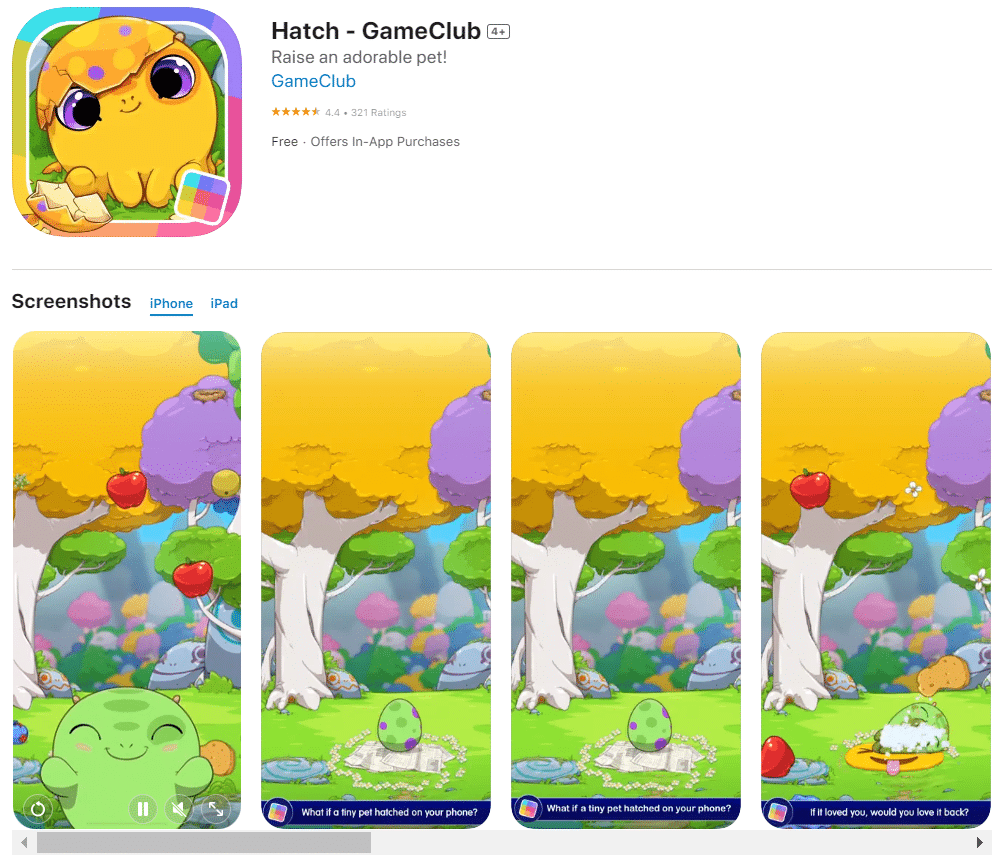
When you set up a pre-launch website, just make sure to collect emails so you can keep your fans updated and let them know when it releases!
On top of building a buzz around your app, having a pre-launch website is also a great way to get some early SEO traction.
This is exactly what Mint did. They built up an incredibly powerful blog months in advance of launching. When it was time to launch, they were already an authority on personal finance with a massive fanbase.
Read more about their story here.
Try to envision a perfect user of your app, what sort of characteristics and traits do they have in common? Once you’ve nailed down the demographic you’ll be targeting, you can adjust your marketing message and gain traction much easier.
An app aimed at the 35-50 year old demographic is going to need a much different approach than an app aimed towards teens. Be smart about using slang, gifs, emojis, or business jargon so as not to alienate potential users.
[bctt tweet=”The more rapidly your app gets downloads, the higher it will rank in the App Store results”]
The higher it ranks in the App Store, the more visibility it gets.
When you first launch your app, this is when the hype will be the strongest so it’s important to use the opportunity to climb the charts as high as you can.
The best way to do this is to plan your launch as far ahead of time as possible and try to align all your marketing efforts to fire simultaneously.
This one’s more of a development tip but can be used for marketing as well. By giving a select group of beta testers the chance to preview your app before it hits the app store you can build a pre-launch user base.
Create and upload a bare bones version of your app to gauge interest and identify which features are most loved.
The reality is that many apps are made that no one will click on, let alone download. By creating a minimum viable product you are able to gauge interest and receive feedback before you invest heavily.
If you’re initially building a webapp for example, software like WebView can help you quickly publish on both the iOS and Android App Stores.
Although it’s not mandatory to start with an MVP, you should somehow find a way to validate your idea before fully committing.
Soft launching, the next step up from beta testing, involves publishing the app but only to a certain smaller region like Canada or New Zealand.
Since the entire app will actually be published, you can get a much larger volume of users to accelerate testing and see how the market reacts.
Apple and Google love to show off their new technology by featuring apps that make good use of it.
For example, Apple often showcases apps that use 3D Touch.
By implementing 3D Touch into your app, you’ll not only improve usability, but you can also get a boost in downloads if you’re chosen to be featured.
The purpose of a style guide is to ensure similar design styles are used across your marketing channels.
Having a document keep track of your color and font choices will come in handy should you ever need to work with a different designer.
This is what ours looks like:
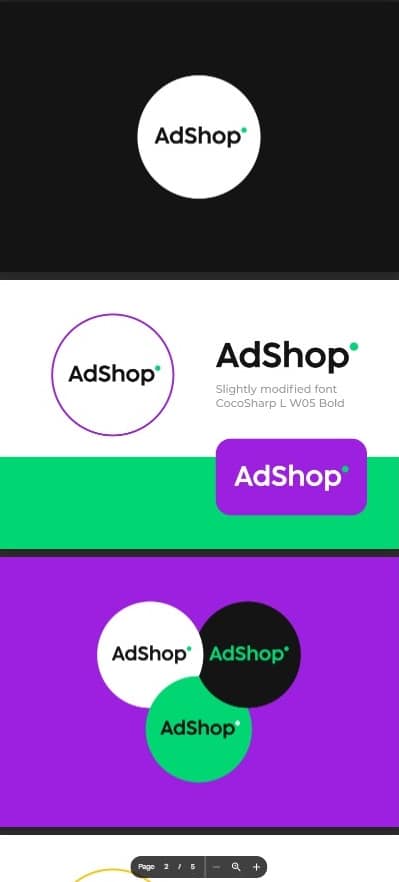
Nothing fancy but it gets the job done.
You can get one made on Fiverr for cheap, just look up “style guide” in the search bar.
Ahh yes, Mr. Sun Tzu… What would a business post be without some parallels to The Art of War? Getting a grasp of your competition will help you carve a niche in the market for your app and shed light on your strengths and weaknesses.
Paid focus groups are a tried and true method of shedding insight on your target consumers. Even with a ton of alternative methods, focus groups can still be a valuable tool in your arsenal.
Start your PR efforts before launching. Journalists and bloggers will appreciate the chance to look at your app before launching.
Even if you don’t plan on doing pre-launch PR, building a list of sites to submit to will make promoting easier when the time comes.
If you don’t want to do it yourself, use Upwork to find a virtual assistant to do it for you.
Make sure to take note of the journalist’s first name, email, and some sort of interest they have which you can use to personalize your outreach emails.
This guide from Mashable describes what it takes to be featured.
Even if you aren’t targeting a big site like Mashable, using the same etiquette when reaching out to any site will come in handy.
Think your app idea is great enough to generate interest and backing before you even release it? Kickstarter helps crowdfund creative projects such as apps, films, albums and more.
If potato salad can raise $50k, why can’t your app?

Like how movies release trailers, sharing teasers of your app will create a buzz before you go live.
Need inspiration? Check out LIMBO’s teaser:
Keep your pitch to journalists short and sweet with a link to your press kit for best results. That way, if they’re interested in writing about your app, they’ll have all of the information they need at the ready.
A few things a good PR kit should include are:
Check out this guide for more info on how to structure your press kit.
When scheduling your launch date, pay close attention to other events going on in your niche which may overshadow your app. Avoid launching at the same time as these events for more exposure.
App Store Optimization involves optimizing your App Store page to rank higher in search results and convert at a higher rate. Follow these tips to maximize your app’s organic downloads.
With keyword optimization, the goal is to get your app ranking in the top search results of the iOS or Google Play Store. To do this, you’ll want to use an ASO Tool such as Sensor Tower or Mobile Action to identify keywords you can rank for.
Screenshots give your potential users a chance to see what you’re offering. It’s tempting to go for flashy, over-the-top images, but the prettiest pictures aren’t always the ones that will lead to the most downloads.
Instead, focus on getting the best parts of your app across to users as quickly as possible. In my experience, exciting in-app screenshots combined with short, to the point text converts the best.
A better app icon can increase conversions by as much as 26%.
When you’re browsing the grocery store, you don’t look for oranges in the dairy aisle. Make sure that your app is in the right category so interested users can find it easily.
Try picking less competitive categories which your app can rank higher in.
To determine how competitive a category is, use App Annie combined with a spreadsheet to plot the top 10 or so apps in each category on a grid with the “overall store rank” on the Y access and the “category rank” on the X axis. The graph should look like this:
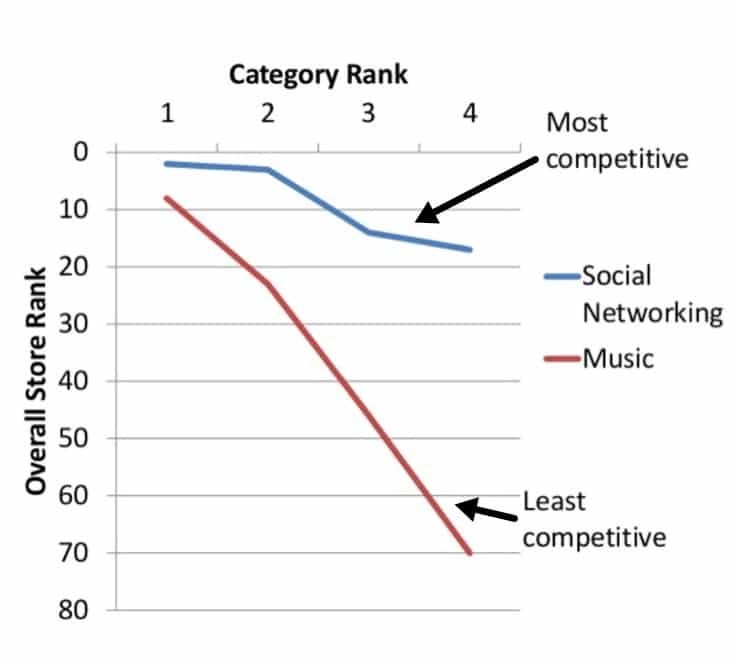
The steeper the line, the less competitive the category is.
Graph and strategy courtesy of Emily Grossman’s post on Search Engine Land.
A great title is your chance to hook users in and get them to click on your app to discover more. It’s also your branding opportunity. Before publishing your app, come up with a unique and exciting title that’ll get app store browsers interested and be easy to search for.
You should also try to include your best keywords in the title since it will help you rank higher in app store search.
A good way to do this is usually done by having a long tail following the actual name of the game, like this:
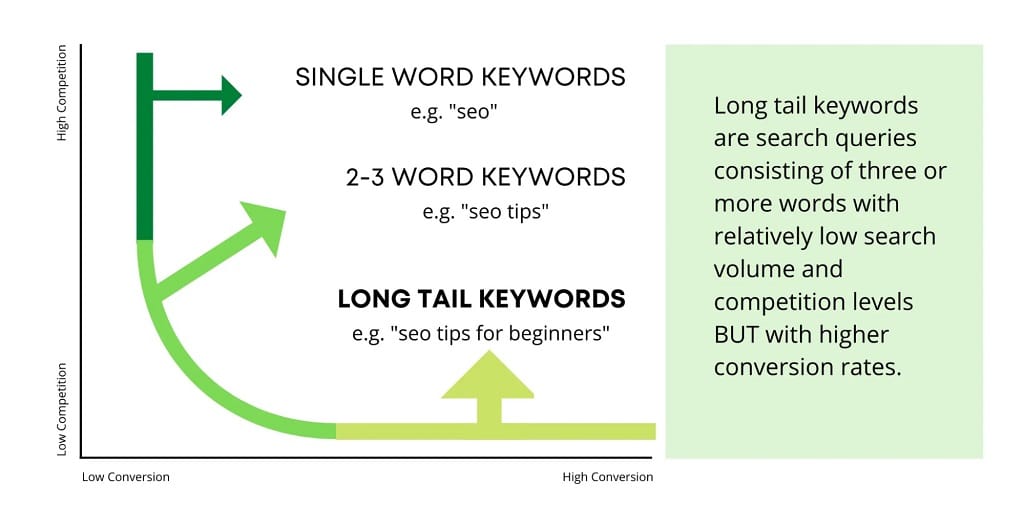
Because of this, you should spend most of your time perfecting your first 2-3 lines since that’s all most people will read.
To take advantage of this, it makes sense to spend most of your time perfecting your first 2-3 lines since that’s all most people will read before downloading, or leaving.
For Google Play, you’ll also need to include your best keywords in the short and long description to rank for them in app store search results.
Learn from your competitors and find new keywords by reading their good and bad reviews.
If your app gets enough reviews on it’s own, you can also use review mining to discover areas of your app that can be improved. Check out this post from Apptamin for a more in-depth look at the process.
iOS and Google Play both allow for a short video preview of your app. Use this to show off gameplay, demo functions, and convince users to try it out for themselves.
Once you have a video made for the App Store(s), you can recycle it by putting it on your website, on YouTube, or even use it in your Facebook Ads.
Apptamin has another great guide on the subject.
There are tons of people who would love to use your app but will never find it because it’s not in their language. Change this by localizing your app page.
Both iOS and Google Play allow you to publish your App Store pages in different languages.
If you’re not sure which language to target first, try this:
Not sure which languages to target first?
Start with these: Chinese, Korean, Japanese, Russian, Italian, French, Spanish, or German.
A/B testing your app page is one of the best ways to improve its conversion rate.
The tests that generally bring the largest increase in conversions are your icon, screenshots, app video, and descriptions.
If your app is on Google Play, you can easily run tests using Google Experiments.
If your app is on iOS, it’s a bit more complicated and a lot more expensive. You’ll need to run a campaign with a service like SplitMetrics or StoreMaven using Facebook Ads or additional traffic sources.
Seeing as a single A/B test on the icon alone can increase conversions by over 25%, it’s definitely not something to ignore.
Social media should always be a part of your app marketing strategy in some way, shape, or form. Here are a few strategies to put the major medias to use.
Use a service like AppsFlyer or onelink.to to create a single link which redirects to each of your App Stores. If someone on an iPhone clicks it, they’ll be taken to the Apple App Store and likewise for Android and Google Play.
This is super handy since it allows you to use a single link across all of your social media profiles without worrying about sending users to the wrong App Store.
Instagram can be a unique way to promote apps where visuals or community are important. It allows you to engage with other users with likes, follows, and relevant hashtags to ensure your content is seen.
You don’t have to always post content from your app either. For inspiration, take a look at Uber’s Instagram page and how they use it to tell stories around their brand.
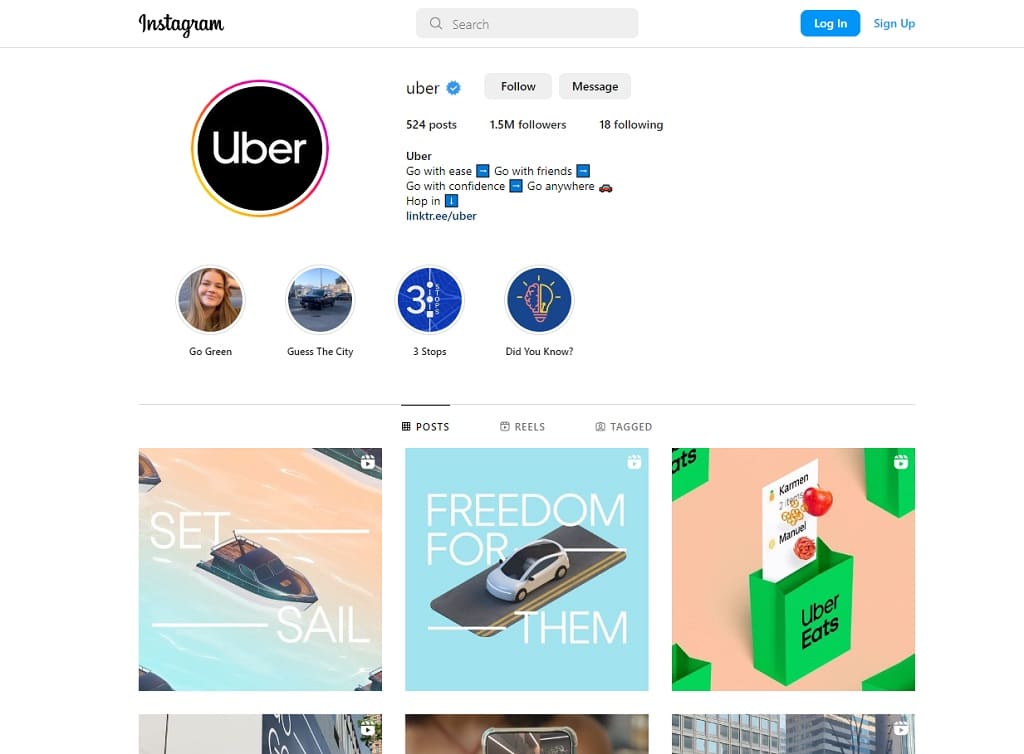
Creating a page for your app on Facebook gives you a platform to share news, updates, and even how-tos or exclusive app tips. Reach out to friends and family to like and share your page; even if they aren’t part of your app’s target demographic, someone on their friends list might be.
Believe it or not, Google+ can still be a valuable place to find and share your content with others in your niche.
Like Facebook, Google Plus contains many groups which you can promote your app in.
Having a Twitter account can be very handy for any developer hoping to promote their app.
Not only does the platform offer a valuable online presence, but it also lets you interact with your users in a friendly and sociable way. Getting in touch with industry leaders can help you make connections and learn from their experience.
Don’t underestimate the power of Pinterest – with over 150 million users, it is a huge opportunity to market your app.
MCNG Marketing offers some in-depth tips on the best ways to optimize app downloads through Pinterest, check it out here.
While Snapchat is a bit trickier to make work from a marketing standpoint, the fact that next to nobody is actually using it for marketing will work to your advantage. Why not be a pioneer!
One feature worth looking into is the Snapchat Geofilters which lets you build custom branded filters users can play with.
Another one is the Snapchat QR code which can direct users to a website or directly to your app page.
If you’re doing a lot of real-life marketing like trade shows or public speaking, Snapchat can be a great way to share this type of content with your users.
YouTube videos are a brilliant way to show your app’s functions and get some more exposure.
If you’ve already created an app preview video for your app page, why not post it on YouTube?
Want to take it a step further? Create something with viral potential!
Although it’s impossible to plan for going viral, if you can pull it off it might be the only marketing your app ever needs.
As Dollar Shave Club has proved, you can build an entire billion dollar business (or app) off of one great video
Getting an endorsement from social media stars or influencers can skyrocket your app downloads.
Check out sites like Shoutcart or Buy Sell Shoutouts where you can buy shoutouts from big influencers.
If you’re serious about influencer marketing, you’ll want to reach out to influencers directly to negotiate cheaper rates and find better opportunities.
If you’re sleeping on Buffer, wake up!
Buffer is a great tool that lets you update all of your social media pages at once. Managing social media pages can be awfully time-consuming, use Buffer to cut down on time spent updating each profile.
This one’s a bit of a no-brainer but definitely worth mentioning. If you take your app just a seriously as other work you’ve done, why not add it to your LinkedIn page like you would for any other job?
Facebook and LinkedIn are full of groups where people gather to share and discuss content. Look for groups in your target demographic that you can promote in.
Before posting your app in every group you find, you’ll have much better results if you find a way to give value as you promote. To do this, try coming up with a real world story to tell or write some valuable content on how your app can come in handy.
Another thing you can do is ask for feedback from your target demographic. Give them exclusive access to the beta version or give out promo codes. Make them feel like they’re part of the team and they’ll be a loyal user for life.
Nothing gets people going like a contest. Whether it’s a simple raffle or a competition of some sort, a contest can get your app attention across the internet.
Social Media Examiner breaks it down well in this guide.
Promoting your app in person might not be your first thought but if your app suits this style of marketing, it can be well worth it.
Make it easier for people to download your app from physical marketing materials such as flyers, posters, and business cards by using a QR code. Minimizing the amount of effort makes it more likely people will give it a try.
This method was famously used by Aaron Patzer, founder of Mint. Neil Patel has a great blog post on their story and how they did it.
“Patzer then went to a train station, stopped people, handed them the concept, and asked them questions like “Does this sound like something you would use?””
Long story short, they sold for $170 million just 2 years later.
Throwing the hottest party in town is a great way to thank your supporters and get the name of your app out there.
Booking app YPlan threw the launch party of the century back in 2013; they even had Pharrell perform live! Even if you don’t have $250k lying around to book Pharrell, you can still host a fun evening with a much smaller budget. This guide shows you how.

Don’t keep your users out of the loop. With tools such as Facebook Live, Snapchat, and Instagram stories, your app users from all over the world can view your events.
Promoting your app in person? Make sure someone is putting your presentation or demonstration online.
For most apps this one will be pretty far fetched but you never know! Even if you don’t make any deals with investors the exposure will be huge.
Get a box of app-based business cards printed and hand them out whenever you have a conversation with someone about your app – it’ll remind them to download it later, and they can pass it along to others.
Throw a QR code on there as well so they can easily download it when they want to.
This not only helps you get involved with the community in your city or state but allows you to make connections with others in your niche.
Reddit subreddits often have meetups where you can meet people interested in the same niche. This will be a great opportunity to gain insight, feedback, and garner further exposure for your app.
Gaining a reputation within your field through sharing your experience and expertise is a long-term way to market your app. When you do speaking arrangements, ask for the organizers to include a link to your app somewhere in the program of events for people to download.
People love selfies! Having a fun photo booth for people to try out at tech events or speaking arrangements is a low budget way to market your app!

This tip works particularly well for apps that incorporate with other technology, like a VR headset.
Set up a booth in a local shopping mall or community event where people can use your app for themselves.
Who doesn’t love a freebie?
One cheap gift you can try are those mobile screen cleaners. How they work is they stick on the back of phones and can be removed to wipe the screen clean. Put your app logo on them along with a QR code so people can download whenever they get a chance.
For example, if you’re promoting a business directory app, ask local businesses if they would like to be featured.
If your app is about promoting healthy eating and offering new recipes, why not offer free downloads to a weight loss group or a gym in your city?
Liven up your voicemail with a quick note about your app – it’s bound to leave an impression on anyone calling you.
For an app that requires community involvement it would be worth a shot. Classified listings can be one of many supplemental advertising tools to consider using as well.
Give back to your community with charity involvement. If you can donate some time, money, or other resources to a local charity that is relevant to your app, you can combine promotion with philanthropy.
Nothing helps promote an app like word of mouth. Get your friends and family to talk to people they know about your app; a genuine recommendation is invaluable and will lead to more downloads.
This section covers strategies you can use to spread the word about your app across the internet and to as many people as possible.
If your app is meant to be used by other businesses, cold calling will likely be one of the best ways to land clients. While it might sound scary at first, it’s actually quite easy when you get the hang of it.
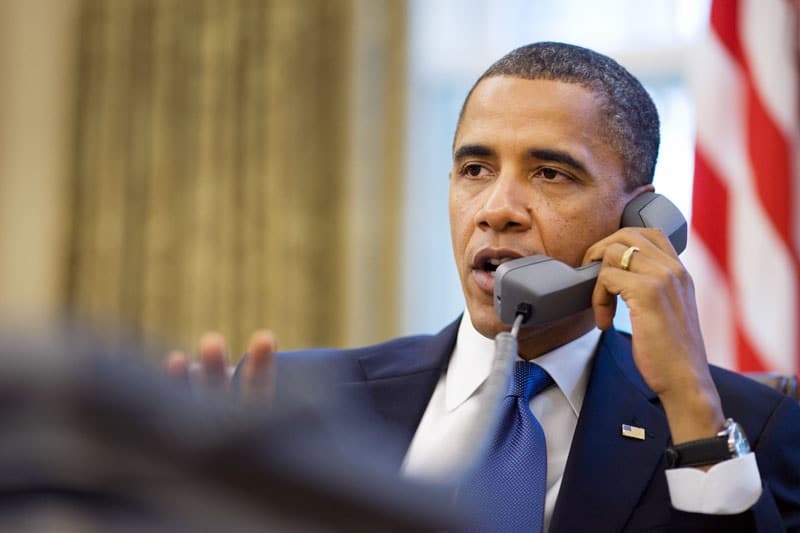
This guide goes into more detail.
If you don’t want to do it yourself, you can always hire someone on Upwork to do it for you. Just make sure you hire someone with experience who won’t tarnish the reputation of your app.
Depending on the type of app you have, cold emailing might be a better choice than calling.
The best part about cold emailing is that once you have a template made, you can contact large groups of people very efficiently.
This story from HubSpot proves that sometimes fortune does favor the bold. Learn from their story when cold emailing potential contacts to promote your app.
Also, check out the app YesWare which lets you execute your cold emailing extremely efficiently.
Giving your app a solid online presence is one way to ensure it makes an impact in App Store rankings. An attractive, well-designed website will provide potential users with more information about your app and increase your legitimacy.
If you decide to publish content to market your app, having a website is an absolute must.
Going viral online can be a long shot – you never know what influencers will respond to and what will take off to become a cultural sensation. Market your app with humor, utilize keywords and tags on social media, and use current trends as a starting point for the chance to go viral.
Also, make sure to encourage sharing as much as possible.
Source: this awesome guide by Buzinga
Creating quality blog content is a sure-fire way to get yourself noticed on search engines. Throw in some links to your app within the posts for some extra visibility.
Once you have your content created, turn it into a slideshow and post it on SlideShare for some extra exposure. SlideShare lets you posts slideshows in an easy to read format and can help you reach thousands of readers who may be interested in giving your app a try. From there, you can link directly to your website or app page.
If you end up making a presentation slideshow for some reason, be sure to post it there as well.
Product Hunt is a website that allows users to discover, share, and vote on new products. Submit your app to the site to reach a wider audience.
Use Deep Links to make sure your app is as convenient to use and access as possible. Read about how to implement this user retention technique in this guide by mobile strategist Alexandre Jubien.
Do you already have an existing app on the app store, or do you know fellow developers seeking new ways to market their app for increased downloads? Cross promotion could be exactly the technique you’re seeking.
You can target users you already know will be interested in your app and increase your downloads.
Most people submit their app and cross their fingers that it gets featured. Why not try reaching out to them directly?
Many big development companies have a contact at Apple or Google who will help them plan to be featured ahead of time. If you can get featured once, the second time will only be easier.
Use a tool like Ahrefs or Moz on your competitor’s website or app pages to find websites that link to them. If a website or blogger links to one of your competitors, why wouldn’t they link to you as well?
Much as with social media influencers, vloggers and bloggers have wide audiences who trust their judgment. Having them promote your app can be huge.
If they won’t promote it for free, try paying them!
Use BuzzSumo to find influencers in your niche sharing related content and get in touch with them directly using Twitter or Email.

You can also use Buzzsumo to see which people in your niche have shared your competitor’s apps and reach out to them directly.
Getting good reviews is always great for building a reputation around your app. Even bad reviews will usually provide useful feedback.
Getting your app reviewed by an established site will put your app in front of more people and increase your downloads.
Make sure to personalize your emails. Nothing bothers review site writers more than seeing impersonal emails in their inbox which were clearly sent to lists of 100s of people.
Set up Google Alerts to find where people are talking about the problem your app solves. You can also use them to track where people are talking about your app directly by setting up a branded keyword alert.

Reddit is “the front page of the internet” and there is a subreddit for every subject you can possibly imagine.
If your app would be of interest to certain people, such as musicians or chefs, seek out a relevant subreddit and let them know – this is a great way to get exposure to a large group of your target audience at once.
Check out these subreddits where app submissions are welcome: r/AppHookup, r/FreeGames and r/FreeGamesOniOS.

Question and answer site Quora might not be the first place you think of in terms of app marketing. However, if you search the site for problems your app can solve and comment with a link, you can potentially get your app seen by thousands of people.

To really make Quora work, make sure that you’re providing value in everything you post. Tell a story or give an example along with your answer and people will be more likely read your full answer and check out your app.
If mainstream media in the US is failing to promote your app and lead to increased downloads, take a tip out of Iliya Yordanov’s book.
The founder of the personal finance app MoneyWiz was disappointed by the lack of responses while trying to get publicity with US media sites.
What did he do?
He translated his app for a few foreign markets like Russia, Spain, Germany, Italy, and France and then reached out to media outlets in those countries. Since these foreign media sources aren’t as sought after as the ones in the US (at least for getting an app featured), they were more eager to write about his app.
When the foreign media outlets picked up on it, the boost in downloads drove the app up all the way to the top spot in the finance category of the App Store.
After jumping to the top of the charts, media outlets in the US had no choice but to take note and pick up on his story too.
Engaging in conversations on relevant forums can be a great way to not only promote your app, but get feedback from people most likely to be using it.
Make sure to read the rules of each forum before participating. Many of them don’t like self-promotion so you’ll have to be careful where you link to your app.
Like every other form of online promotion, approach forums from the view that you’re going to be giving value to everyone you interact with.
If someone is talking about a problem they’re having, offer helpful advice along with a gentle nudge to check out your app. It will take more time this way but it will pay off in the long run.
Everyone loves to get a behind the scenes glimpse, whether it is a special “making of” featurette on a DVD or backstage stories from an awards show. Give your users a sneak peek into your motivation and process for creating the app by blogging, vlogging, tweeting or posting about your story.
Having a story will also be extremely helpful in creating an angle when pitching to journalists and reviewers.
It seems like everyone is listening to or creating podcasts nowadays – reach your target demographic by appearing on their favorite podcast and telling your story.
Guest blogging can help establish your authority in your area of expertise. If you choose wisely and target blogs with high readership, you’ll reach a brand new market which will convert into more downloads for your app.
Check out Brian Dean’s guide to make sure you nail your next guest blog post.
StumbleUpon allows users to search for and discover new entertainment across the web that is tailored to their unique tastes – a perfect form of targeted, personalized marketing for your app.
If you have your own personal website, write a blog post about your app’s story. If you don’t have a website,
you can do the same on your Facebook, Twitter, or Instagram.
Not only does collaboration lead to great content, but it also expands your network and gives you access to your creative partner’s audience.
There’s a reason why we always click into the reviews section before we buy anything on Amazon – we want to see whether it’s any good! Let your potential users know how great your app is with positive testimony from existing users.
If your app had won any awards, make sure to mention it!
Again, this tip will vary in success depending on the type of app you are promoting. A finance app aimed at investors will probably not benefit from engaging in viral trends and hashtags as much as an app aimed at teens.
Whenever you connect with a blogger or guest host a podcast, offer limited time promo codes for free downloads or in-app purchases. This will encourage listeners or readers to download quickly so as not to miss out, spiking your sales and helping your app rise through the rankings.
Think of promoting your app like starting any good habit, like going to the gym. It doesn’t matter how hard you work the first week if you quit by the second. Keep yourself motivated to continue promoting your app with a marketing calendar.
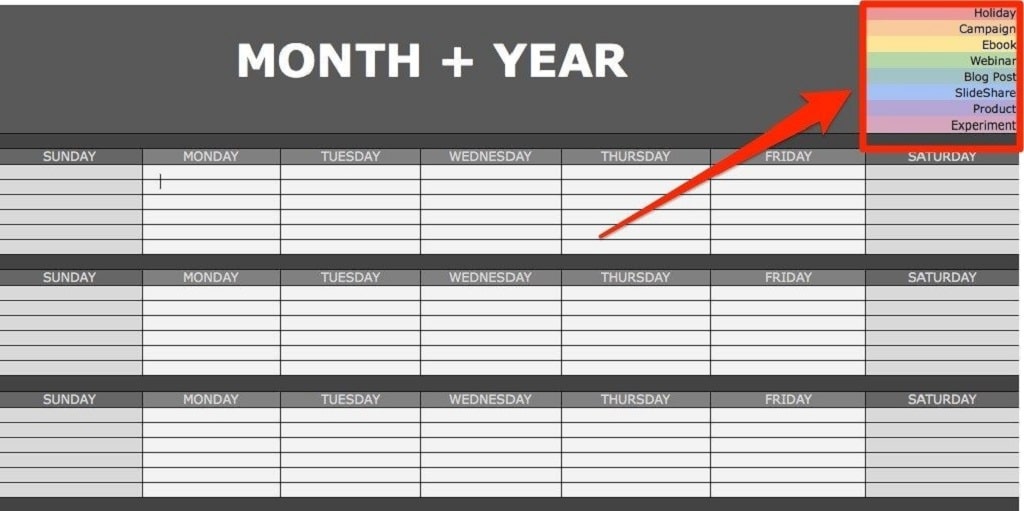
Whether you choose to do this on your blog, Twitter, or even on a site such as Reddit that hosts AMA (Ask Me Anything) sessions, it’s a great way to promote your app on a personal level.
If you think you’ve got something truly special and unique with your app, why not enter your app in for an award?
There are numerous contests to enter, even if you’re a new or small developer. If you win, the prizes can be lucrative and a great career boost – but even if you don’t, the publicity for your app during the contest can act as free marketing.
Paid ads are what separate the indie devs from the big dogs. While they tend to be higher risk than the other techniques we mentioned so far, if you can pull it off, the upsides are enormous.
The best way to get the most bang for your buck with paid ads is to use them to break into the top charts for its chosen category.
The more downloads an app gets within a short period of time, the higher it will rank in the top charts. To use this to your advantage, you’ll want to make sure you pay for installs in bursts. You’ll get a much higher ROI out of your ad budget if you spend it within a 1-2 week period.
Paid ads are a great way to help speed up your soft launch and iron out bugs.
For example, let’s say you’re soft launching in Canada to get some initial feedback and tweak the app before taking it to a larger audience. You can use paid ads by targeting traffic in Canada to quickly get new users.
Then, you can use your analytics platforms to see how people are using the app and make adjustments before launching in the larger markets like the US.
Facebook’s ads platform is great at letting you laser target your desired audience by their interests, location, and much more. Facebook Ads can also let you retarget people who have downloaded your other apps or visited your website.
This post by Apptentive explains Facebook Ads for apps in detail.
With Search Ads, you can promote your app right at the top of the App Store search. Although Search Ads are fairly new and experimental, with no minimum spend and a completely flexible approach, this can be a relatively low budget marketing strategy that reaps high rewards if you use it properly.
To do that, check out this guide by Growth Pilots.
Google AdWords allows you to directly advertise your app on Google SERPs. You can choose from a variety of options, including ads that, when tapped, will send the user straight to the App Store for a swift and easy download.
This guide shows you how to make AdWords work for app install campaigns.
There are tons of ad networks out there that allow you to buy ad space in other apps.
To name a few, check out Applovin, Chartboost, or Appbrain.
Apptamin has a great guide on this.
Here’s a pretty sweet example:
Use these tips to take advantage of that and keep people using your app.
Once you’ve got your marketing down pat in your native language, consider having the app translated to target different countries.
A good strategy we mentioned above is to first translate only your app store page and keywords at first, then choose the countries with the most downloads to target for full on translation.
Offering your users a bonus or benefit when they promote your app online is a sure way to get them to spread the word. This post from Localytics explains how Dropbox used referrals to exponentially increase their user base.
“Dropbox is an often-heralded example of how to succeed with this method. When users first sign up, Dropbox offers them the option to get an additional 500MB of space for every friend they get to sign up. Users can accumulate up to 16GB this way, if they’re high school cheerleader level of popular.“
How well did this work? It got Dropbox from 100,000 users to 4,000,000 users in just 15 months! No arguing with those numbers.
App Virality has a great platform for facilitating these types of referrals.
If people are using your app constantly, they probably enjoy it! Give them the opportunity to express their opinions with a popup invitation to leave a review.
By targeting your most frequent users, you improve the chances of receiving positive feedback from people who find your app useful or entertaining.
To set this up, check out Apptentive.
Whenever you prompt users to leave reviews and ratings, give them the option of connecting with your support team via email. You may learn about a flaw in your app that has previously gone unnoticed, or discover new features that people would like to see.
There are numerous places online where you can pay for positive reviews on your app. However, like minor celebrities buying fake twitter followers, this will be completely transparent to everyone who views your app, and will make you seem untrustworthy.
If you build a great app and use these marketing techniques to properly promote it, the positive (and honest!) reviews will follow.
Give your users incentives to use your app more frequently and remain active with rewards and bonuses. For instance, in a game app you can give your players extra lives or character features once they have spent a certain amount of time on the app.
If your app represents a business, you could offer a rewards program for repeat customers.
A stagnant app will be abandoned by users once they grow bored with it. Keep your users interested and engaged by planning ahead to new content and feature updates.
Businesses use sales and discounts because they work. Offer premium content at a lower price for a limited time for a boost in sales.
Remind your users why they downloaded your app and keep it fresh in their minds by celebrating major milestones. For example, you can offer extra features or a free trial of the premium version of your app whenever you hit 1,000,000 downloads, or celebrate the 1 year anniversary of your launch with a giveaway.
Have you ever opened your phone to do something important when a push notification comes up at exactly the wrong time? Bombarding your users with irrelevant push notifications is annoying and will drive them away.
Use them wisely and sparingly for greater effect and to retain active users.
Think of apps like Words with Friends – part of what makes them so popular is the sense of competition as users battle it out to make regional and global scoreboards. Incorporating this type of feature into your app is a tried and tested way to keep users coming back for another round.
Use a trusted attribution platform like AppsFlyer or Kochava to keep track of where your downloads are coming from. Double down on winning marketing channels and cut or tweak the losers.
The cool thing about these platforms is the level of detail they can track. For example, they can not only tell you which channels are performing the best, but also which ones are bringing in the most in-app purchase sales.
If you’ve got the moula, give these big budget app marketing strategies a try.
If you have enough money to spend on promoting your app, a primetime TV advert is a brilliant way to reach hundreds of thousands of potential users.
Clash of Clans saw a significant spike in downloads and active users after their 2015 Super Bowl ad starring Liam Neeson. If you’re not quite at a Superbowl level budget, you can also boost downloads and promote your app through adverts on your local TV station or smaller networks.
AppsFlyer can actually help attribute downloads from TV programs by tracking when the commercial was shown and attributing downloads at that time to the ad.
They may seem like an outdated form of advertisement, but if your app has incredible graphics and you have a big budget, displaying it across the sky is a sure way to get attention – making everyone who passes through the area a potential user.
Anyone who has binge-watched Netflix’s hit show House of Cards will remember President Frank Underwood’s video game hobby. In season 3, he adopts the mobile app Monument Valley as his game of choice, leading to skyrocketing downloads.
Although the House of Cards team actually approached the app developers in this case, traditional product placement can be a valuable tool for app promotion if you have a large budget.
As you can see, regardless of your budget, there are always ways to market your app if you’re willing to get a little creative.
If you’ve read the whole post, congratulations! You’re now ready to start testing some strategies to find out what does and doesn’t work for you.
If you haven’t read the whole post, scroll back up and read it!
If you want help picking strategies that will have the most impact for you, tell me about your app in the comments or email me directly and I can give you some advice.
Finally, if you enjoyed the post and think others would too, please share it!

Learn how to plan, execute and analyze a successful marketing campaign.

Understand the key differences between advertising and marketing.